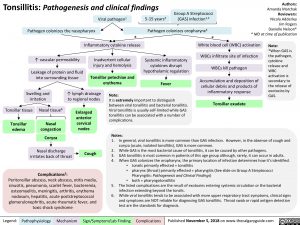Tonsillitis: Pathogenesis and clinical findings
Group A Streptococci (GAS) infection1,2
Authors:
Amanda Marchak
Reviewers:
Nicola Adderley Jim Rogers Danielle Nelson* * MD at time of publication
Viral pathogen1
5-15 years3
Pathogen colonizes the nasopharynx
Pathogen colonizes oropharynx4 **
↑ vascular permeability Leakage of protein and fluid
into surrounding tissue
Inflammatory cytokine release
Inadvertent cellular injury and hemolysis
Tonsillar petechiae and erythema
Systemic inflammatory cytokines disrupt hypothalamic regulation
Fever
White blood cell (WBC) activation WBCs infiltrate site of infection
WBCs kill pathogen
Accumulation and deposition of cellular debris and products of inflammatory response
Tonsillar exudate
Note:
*When GAS is the pathogen, cytokine release and WBC activation is secondary to the release of exotoxins by GAS.
Swelling and irritation
↑ lymph drainage to regional nodes
Enlarged anterior cervical nodes
Cough
Note:
It is extremely important to distinguish between viral tonsillitis and bacterial tonsillitis. Viral tonsillitis is usually self-limited while GAS tonsillitis can be associated with a number of complications.
Notes:
Tonsillar tissue
Tonsillar edema
Nasal tissue6
Nasal congestion
Coryza
Nasal discharge irritates back of throat
Complications5:
Peritonsillar abscess, neck abscess, otitis media, sinusitis, pneumonia, scarlet fever, bacteremia, osteomyelitis, meningitis, arthritis, erythema nodosum, hepatitis, acute poststreptococcal glomerulonephritis, acute rheumatic fever, and toxic shock syndrome
1. In general, viral tonsillitis is more common than GAS infection. However, in the absence of cough and coryza (acute, isolated tonsillitis), GAS is more common.
2. While GAS is the most bacterial cause of tonsillitis, it can be caused by other pathogens.
3. GAS tonsillitis is most common in patients of this age group although, rarely, it can occur in adults.
4. When GAS colonizes the oropharynx, the primary location of infection determines how it’s identified.
• tonsils primarily effected = tonsillitis
• pharynx (throat) primarily effected = pharyngitis (See slide on Group A Streptococci
Pharyngitis: Pathogenesis and Clinical Findings) • both = pharyngotonsillitis
5. The listed complications are the result of exotoxins entering systemic circulation or the bacterial infection extending beyond the tonsils.
6. While viral tonsillitis tends to be associated with more upper respiratory tract symptoms, clinical signs and symptoms are NOT reliable for diagnosing GAS tonsillitis. Throat swab or rapid antigen detection test are the standards for diagnosis.
Legend:
Pathophysiology
Mechanism
Sign/Symptom/Lab Finding
Complications
Published November 5, 2018 on www.thecalgaryguide.com
Foundations
Systems
Other Languages
Pediatrics Common Pediatric Infections Tonsillitis: Pathogenesis and clinical findings Tonsillitis: Pathogenesis and clinical findings

